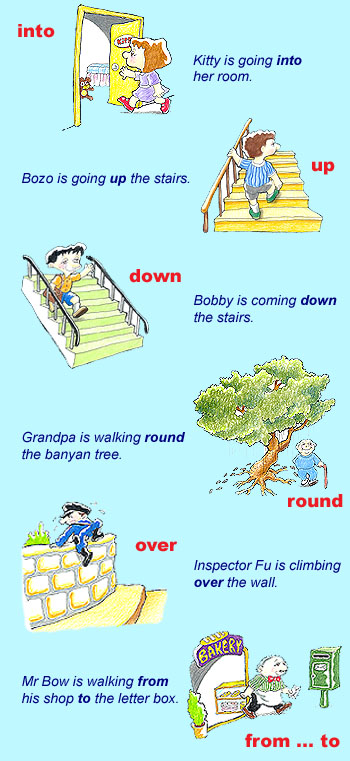| Indicating movement (to) |
Prepositions indicating 'movement' tell us where something moves to, or in what direction something moves:

When prepositions express 'movement', they always work together with a noun group, forming a 'prepositional phrase':
Kitty is going into her room.
Bozo is going up the stairs.
Bobby is coming down the stairs.
Grandpa is walking round the banyan tree.
Inspector Fu is climbing over the wall.
Mr Bow is walking from his shop to the letter box.
| If you would like to practice choosing the correct prepositions to express movement, click here: |  |
Sometimes different prepositions of 'movement' can be used to express a subtle difference in meaning:
Bozo and Barney were walking across the grass. [short grass = lawn]
Felix was moving carefully through the grass. [long grass]
The distinction made here is similar to the one made with prepositions of 'place':
Bozo and Barney were walking on the grass. - Bozo and Barney were walking across the grass. [short grass = lawn]
Felix was hiding in the grass. - Felix was moving carefully through the grass. [long grass]
When choosing a preposition of movement, it helps to think about prepositions as a way of arranging an object in one of four different ways:
| Prepositions of movement | ||
| type | meaning | example |
| 0 | point or location (without any dimension of space) |
Mr Gong drove his car to the office. Mr Gong drove from home to work. |
| 1 | line (one-dimensional space) |
Mr Gong drove down the road to Stanley. |
| 2 | area or surface (two-dimensional space) |
Mr Gong drove his car onto the grass. |
| 3 | enclosed space or
container (three-dimensional space) |
Mr Gong drove his car into the garage. |
When we use a preposition to indicate 'movement', we consider not only where the movement is taking us but we also think about the kind of place it is taking us to. For example, we can think of a road as a line that takes us from one place to another, or as an area:
The taxi went down Aberdeen Street. [line = Type 1]
Mr Wing drove his bus onto a slippery road. [surface = Type 2]
When choosing a preposition of movement, you should ask yourself how the place is perceived. Is the place a line to somewhere (down Aberdeen Street), or is it an area or surface (onto a slippery road)?
For a list of prepositions with meanings and examples, click on the menu on the left:
Word classes: Prepositions: Preposition formation
For a PrimeTeach teaching activity which provides KS2 students with practice
in using prepositions to indicate direction, see:
![]() Hokey cokey
Hokey cokey
|
||
To give us feedback about this section, click here or on the Comment button at the top of the screen.
If you have any questions about this section, visit the Language Corner.
If you have any questions or suggestions about how to teach this section, send a message to the Teaching Corner.